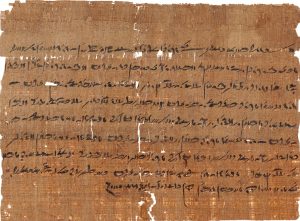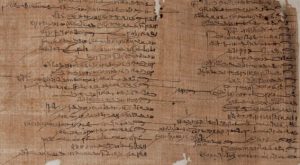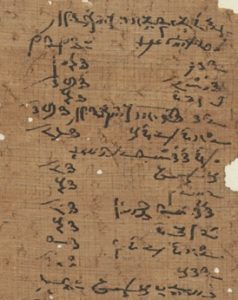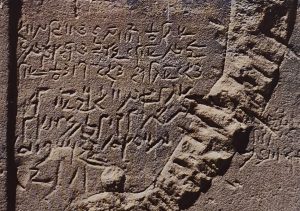III. Diachronic development of Demotic
Demotic has traditionally been divided into three main stages due to certain developments, changed circumstances and new features in the script. For the most part, this periodization also coincides with the historical development of Egypt. In order to showcase the development of Demotic over time, some text samples have been chosen to accompany the written text.

As already mentioned, Demotic developed from the Hieratic script. This development probably came to pass during the Third Intermediate Period (ca. 1100-650 BCE), when Egypt did not have a central government. While in the south a complex form of Hieratic was still used for all bureaucratic matters (referred to as Abnormal Hieratic), a new script evolved in Lower Egypt, especially in the Delta. This Early Demotic script is first attested during the Saite Period (ca. 650-520 BCE) and seems to have quickly spread all around Egypt. It was then only used for administrative and business matters and was thus limited to documentary texts.

With the reign of the Ptolemies (ca. 330-30 BCE), Demotic was in common use all around Egypt. Although, a Greek administrative system was introduced with the Ptolemies, Demotic was still the language used on a local level. It was during this stage called Ptolemaic Demotic, that this language was first used for literary texts such as wisdom texts (e.g. the teachings of Onchscheschonqi) or narratives (e.g. the tales of Setne Khaemwaset).

Already during the late reign of the Ptolemies, but at the latest at the beginning of the Roman rule around 30 BCE, an important innovation also spread among Egyptian scribes: The long-used rush pen was replaced by the reed pen introduced by Greek scribes. This reed pen enabled finer line drawings and is a distinguishing feature of Roman Demotic. Furthermore, ligatures
became less frequent and alphabetic writings increased during this time.

As Greek became more and more influential in the administration, also on a local level, the Demotic language ceased to be used for documentary texts. Thus Demotic was almost only produced in the Egyptian temples for internal administration and especially for literary and religious texts. In fact, a zenith of these texts can be observed in the first and second century CE. Lastly, this limitation to the temples led to the slow demise of Demotic which was only cultivated by the remaining families of Egyptian priests in an increasingly Christian environment. The last securely dated Demotic text is a graffito from Philae from 452 CE.
For further reading on the development of Demotic see Stadler, M. A., On the Demise of Egyptian Writing. Working on a Problematic Source Basis, in: Baines, J. / Bennet J. / Houston, St. (Hgg.), The disappearance of writing systems, London 2008, 157-181.